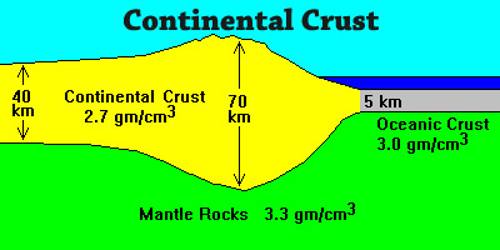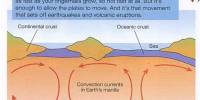Continental Crust
Definition
Continental crust is the solid, outermost layer of the Earth, lying above the mantle. This layer is sometimes called sial because its bulk composition is more felsic compared to the oceanic crust, called sima which has a more mafic bulk composition. The crust that includes continents is called continental crust and is about 35.4 to 70 km (22 to 43.4 mi) thick. It consists mostly of rocks, such as granites and granodiorites that are rich in silica and aluminum, with minor amounts of iron, magnesium, calcium, sodium, and potassium.
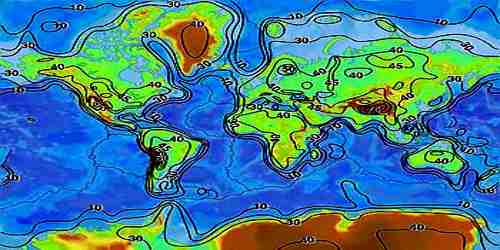
Consisting mostly of granitic rock, it has a density of about 2.7g/cm3 and is less dense than the material of the Earth’s mantle, which consists of mafic rock. Continental crust is also less dense than oceanic crust, though it is considerably thicker; mostly 35 to 40 km versus the average oceanic thickness of around 7-10 km. About 40% of the Earth’s surface is now underlain by continental crust.
The crust that includes ocean floors is called oceanic crust and is about 4.8 to 9.7 km (3 to 6 mi) thick. It has a similar composition to that of continental crust, but has higher concentrations of iron, magnesium, and calcium and is denser than continental crust. The predominant type of rock in oceanic crust is basalt.
Formation and Forces at Work of Continental Crust
There are two types of crust: continental and oceanic. Continental crust is the crust under which the continents are built and is 10-70 km thick, while oceanic crust is the crust under the oceans, and is only 5-7 km thick. The crust isn’t one large piece; rather, it’s more like an egg shell that has been cracked repeatedly. The crust contains sections, called plates. Just like the floatation devices resting on top of a pool of water, these plates are continually on the move. When they hit each other, slide along each other, or move away from each other, you can get earthquakes and volcanoes.
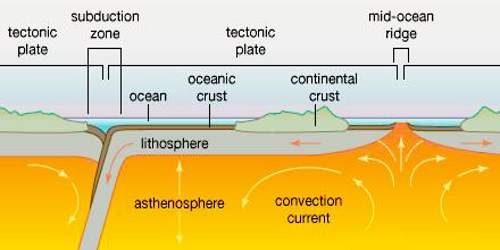
Continental crust is more complex than oceanic crust in its structure and origin and is formed primarily at subduction zones. Lateral growth occurs by the addition of rock scraped off the top of oceanic plates as they are subducted beneath continental margins. The continental crust formed through these interactions between plates. When two plates collide, one plate can subduct beneath the other. Subduction is simply the process by which one plate moves underneath another plate.
Continental crust resists subduction. Consequently, the mean age of the continents is almost two billion years, more than 30 times the average age of the oceanic crust. Thus, continents are the prime repositories of information concerning Earth’s geologic evolution, but understanding their formation requires knowledge of processes in the ocean basins from which they evolved.
Today there are ~7 billion cubic kilometers of continental crust, but in the past there may have been fewer or more. The relative permanence of continental crust contrasts with the short life of oceanic crust. As a consequence of the density difference, when active margins of continental crust meet oceanic crust in subduction zones, the oceanic crust is typically subducted back into the mantle. Because of its relative low density, continental crust is only rarely subducted or re-cycled back into the mantle.
The height of mountain ranges is usually related to the thickness of crust. This result from the isostasy associated with orogeny (mountain formation). The crust is thickened by the compressive forces related to subduction or continental collision. The high temperatures and pressures at depth, often combined with a long history of complex distortion, cause much of the lower continental crust to be metamorphic – the main exception to this being recent igneous intrusions. Igneous rock may also be “underplated” to the underside of the crust, i.e. adding to the crust by forming a layer immediately beneath it.
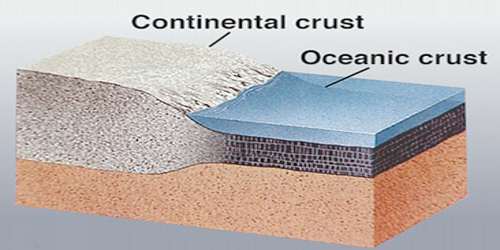
Importance of Continental Crust
There is little evidence of continental crust prior to 3.5 Ga, and there was relatively rapid development on shield areas consisting of continental crust between 3.0 and 2.5 Ga. All continental crust ultimately derives from the fractional differentiation of oceanic crust over many eons. This process has been and continues today primarily as a result of the volcanism associated with subduction. Because the surface of continental crust mainly lies above sea level, its existence allowed land life to evolve from marine life. Its existence also provides broad expanses of shallow water known as epeiric seas and continental shelves where complex metazoan life could become established during early Paleozoic time, in what is now called the Cambrian explosion.
Today there are ~7 billion cubic kilometers of continental crust, but in the past there may have been less or more. Today continental crust is produced and destroyed mostly by plate tectonic processes, especially at convergent plate boundaries. New material can be added to the continents by the partial melting of oceanic crust at subduction zones, causing the lighter material to rise as magma, forming volcanoes. Also, material can be accreted “horizontally” when volcanic island arcs, seamounts or similar structures collide with the side of the continent as a result of plate tectonic movements. Continental crust is also lost, due to erosion and sediment subduction, tectonic erosion of forearcs, delamination, and deep subduction of continental crust in collision zones.
Reference:
